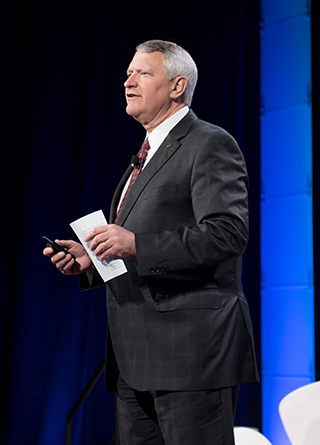 While new healthcare technologies should be key resources for overwhelmed providers, American Medical Association President Dr. David Barbe said during a keynote address at the Connected Health Conference in Boston last week that his organization is concerned that past and upcoming solutions could be adding more fuel to the growing issue of physician burnout.
While new healthcare technologies should be key resources for overwhelmed providers, American Medical Association President Dr. David Barbe said during a keynote address at the Connected Health Conference in Boston last week that his organization is concerned that past and upcoming solutions could be adding more fuel to the growing issue of physician burnout.
“We listen to what physicians around this country say and they’re telling us loud and clear that in many cases technology isn’t working for them, and in many cases they are feeling burned out because of the stresses of the current environment of practices,” Barbe explained to an audience of health tech players and entrepreneurs. “How do we collectively … help move the dial on that? How do we make technology work better for physicians? How do we begin to reduce burnout in the physician community?”
Physician burnout may not be a new problem for healthcare, but the issue has become a renewed concern for the AMA. Barbe cited 2011 and 2014 data collected by the Mayo Clinic suggesting that more and more doctors are feeling overwhelmed. The most recent numbers suggest that half are experiencing at least some degree of burnout, which Barbe warned can lead to worsened cognitive functions, more mistakes, early retirement, depression, and suicide.
Many of the factors contributing to these increasing rates — including increased regulation, payment system changes, poor EHR systems, and time demands — could be addressed with new technologies, Barbe argued. According to data from the AMA’s 2016 Digital Health Survey, nearly half of the organization’s respondents said that they are enthusiastic about adopting various new digital healthcare solutions in their practice.
“Now, that’s good in the sense that we’ve got 50 percent of the docs that are in there, and they want to go forward with this stuff,” Barbe said. “But that also means there are 50 percent that are pretty reluctant.”
Unfortunately, physicians in the latter group have good reason to be wary of new technologies, he explained. Many technologies that have been introduced thus far have had a detrimental impact on practitioners’ workloads, and can generally be overwhelming for providers already teetering on the edge of burnout.
“The technologies that we have presented to them so far add more work to their day, interfere with their relationships with their patients, and often cost them much more, both directly and indirectly, than they can recognize and benefit,” Barbe said. “We collectively have a lot of work to do to move the needle in these dimensions, both to increase the physicians’ excitement about adopting these new technologies as well as making them work for them instead of against them.”
 But all of this isn’t to say that physicians aren’t open to new technology. Again, Barbe pointed to that 50 percent of respondents who expressed interest in technology in the AMA survey, and stressed that novel solutions capable of increasing patients’ care or workplace efficiency will always be amenable to providers — especially when a quick glance toward other industries offers a glimpse of what healthcare is missing.
But all of this isn’t to say that physicians aren’t open to new technology. Again, Barbe pointed to that 50 percent of respondents who expressed interest in technology in the AMA survey, and stressed that novel solutions capable of increasing patients’ care or workplace efficiency will always be amenable to providers — especially when a quick glance toward other industries offers a glimpse of what healthcare is missing.
“[Physicians] look at technologies in other sectors … and they see all these technologies that are just great, everybody wants them and everybody uses them,” Barbe said. “And they look around and say, ‘Why is the app they developed [absent] from healthcare? Why isn’t it as good for me in healthcare as it is when I go to shop, or on social media?’ They’re eager for the advances that we know are there, and the potential for even greater ones, but they’re just not experiencing that right now.”
For their part, Barbe said that the AMA is working to introduce its members to mobile and online apps designed to streamline care or fast-track the other clerical burdens that can lead to physician burnout. Outside of these efforts and his organization’s regular work in physician education and public policy direction, Barbe called on the digital health community to keep the flagging physician in mind when designing new solutions.
“We simply cannot afford to have this decrease in productivity and engagement in one of the critical parts of our healthcare system," he said. "We have to get our arms around this issue of physician burnout.”
















